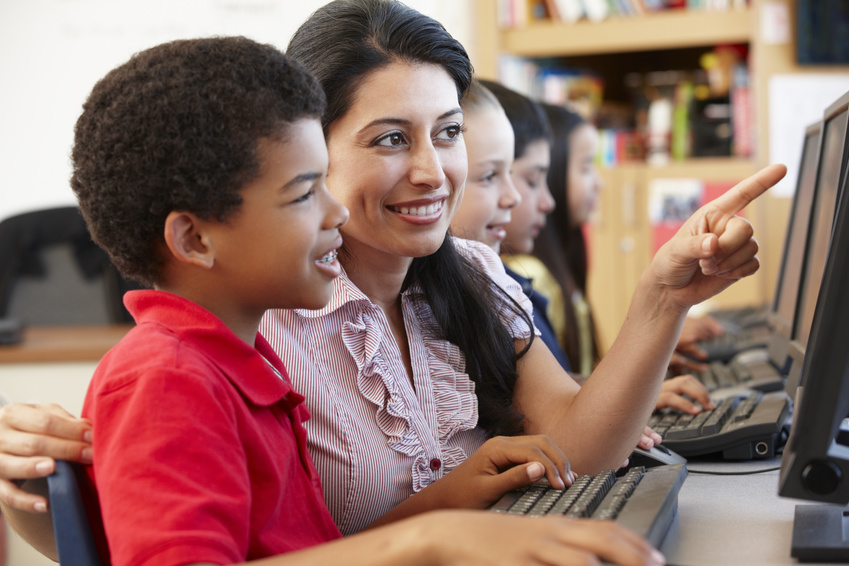Angela entered middle school with a strong foundation in reading, writing, and math. However, middle school teachers expected her to use unfamiliar technology, causing her to feel lost in many lessons. Although her elementary school was academically rigorous, it had neglected to incorporate adequate technology lessons. Angela’s computer literacy deficit made accessing the content in middle school stressful and frustrating.
Recognizing their mistake, the staff at Angela’s former elementary school changed their approach to teaching technology. Teachers introduced lessons focusing on fundamental computer skills and empowered students to learn, create, and collaborate. Students began to hone their skills using learning software with rapid feedback and enhancing projects with multimedia such as music, videos, pictures, and animation. Students transitioning out of that elementary school now have the computer literacy skills to thrive in middle school.
Educators without a strong technology background may feel unsure about how to start integrating technology in their lessons. If that describes you, start with reading Essential Digital Literacy Skills to Teach Digital Natives. Now that you have an overview of digital literacy, this scope and sequence will give you an idea of what to teach in different grades. These guidelines are a starting place and not meant to replace your state standards nor information from your assessments.
Students should master the following skills by 1st Grade:
- Asks permission before going to any game or website not pre-approved.
- Understands and uses computer-related vocabulary, such as the hardware and basic operations.
- Knows how to turn on a device and shut it down properly.
- Opens and exits programs and apps.
- Understands how usernames and passwords protect privacy and account settings and can successfully log in using them.
- Understands the importance of logging off and how to do it.
- Uses icons and arrows to navigate to desired locations.
- Uses a touch screen, mouse, or mouse pad to click, drag, double click, and scroll.
- Ability to use the standard keys on the keyboard such as backspace, space bar, letters, and numbers.
- Can adjust the volume on headset or speakers to appropriate levels. Too many children suffer hearing loss from having the volume of their headphones too loud.
- Independently follows multi-step directions such as turning on a computer, opening an application, logging on, choosing a specific menu item, using the application, saving work, and logging off.
Students should master the following skills by 3rd Grade:
- Understands the different types of devices and their benefits.
- Distinguishes between being online versus offline and asks permission before going to any new website.
- Can play, pause, rewind, and forward videos.
- Saves, names, finds, and prints documents.
- Uses a child-friendly search engine to find information.
- Uses a word processor to write, highlight, copy, and paste text in documents.
- Draws and paints with simple programs.
- Uses some multi-key functions such as Shift and letter for capital letters and Control Z for undo.
Skills to Master by 5th Grade:
- Follows online safety guidelines set by adults.
- Understands the potential damage and permanence of anything posted online.
- Reads error messages and follows simple troubleshooting directions.
- Types with fingers on the home keys rather than hunting and pecking.
- Uploads and resize images.
- Edits documents with proofreading and formatting tools.
- Finds specific websites and navigates the menu options.
- Understands the different types and purposes of websites.
- Shares and collaborates using simple EdTech tools.
- Conducts online research and analyzes the information for credibility.
- Knows how to write and send an email.
Skills to Master in Middle School
- Recognizes when a website is not safe or appropriate.
- Identifies common problems and troubleshoots them effectively, such as reloading a frozen website and reconnecting to the internet.
- Understands the different methods for storing data (thumb drive, hard drive, cloud, etc.) and when each one is most useful.
- Collaborates with others using comment features, message boards, digital whiteboards, and more.
- Creates and shows multimedia presentations with pictures, music, and interesting transitions.
- Creates simple graphs, tables, and spreadsheets to show information.
- Understands how social media posts affect themselves and others. If the school encourages social media participation, students follow rules of conduct.
- Knows how to download, rename, and find various file types.
- Understands the basic ideas behind intellectual property to avoid copyright infringement. Gives credit to original creators with links and names when mentioning or using their work.
Skills to Master in High School:
- Protects themselves online from phishing, viruses, scams, identity theft, and radicalization.
- Chooses which (if any) social media platforms are helpful and how to stay safe on them.
- Customizes settings to optimize their experience.
- Integrates various applications such as email, calendar, and reminders.
- Uses proper etiquette when communicating via email, social media, and message boards.
- Understand how different technology systems work together.
- Independently learns new computer skills using directions, videos, and other resources.
- Uses specialized technology in fields of interest.
Just the Beginning
These basic skills will allow students to interact with technology in school and daily life. As you and your students gain proficiency, you may expand into other computer-related domains such as coding, programming, and creating original work.
Harris Education Solutions partners with educators to help teachers and students thrive. As software providers, we understand that adapting to technology takes time and practice. That is why we provide robust training and support to help you get the insights you need. Visit our solutions page to see which product will most benefit the teachers and students at your school.

